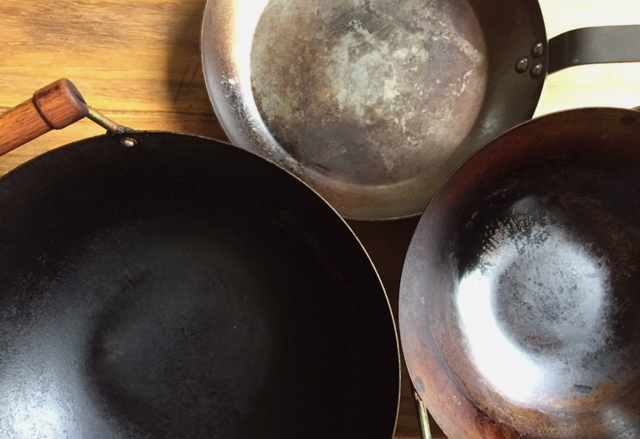
I love my well-worn wok but have been looking for a pan that will allow me to sear and toss around lots of food at high heat. The six-inch wide wok bottom isn’t efficient for certain things. I have cast-iron skillets but they’re heavy. In fact, last week while cooking at my mom’s house, I used her deep cast-iron skillet to stir-fry and in between dishes, running back and forth from the stove to the sink with an 8-pound skillet was no fun.
After much consideration, I settled on an 11-inch carbon steel skillet which weighs about 4 pounds. (My wok weighs roughly the same.) The M’steel pan by Mauviel had to be washed and seasoned. I’ve seasoned woks before and knew that you have to first remove the factory coating of oil – or in the case of the French skillet I bought, a coating of beeswax. That wasn’t easy. Instructions called for “very hot” water so I boiled a kettle of water and poured it all over the skillet. Grey stuff came off. I scrubbed the skillet with dish soap and hot water, as Mauviel suggested. I also singed my fingertips in the process. Oh well. Most of the wax was removed.
Then it was on to seasoning the skillet to coat the interior with a thin coating of oil. The Mauviel instructions were just for using a light film of oil and heating it for 5 minutes. Cool, wipe clean with paper towel then repeat. Curiosity got me going and I also watched a YouTube video from Vollrath, a kitchen product maker.
The chef suggested that ten or eleven coats of flaxseed oil be applied to get a black coating like what I had on my wok after about ten years. I was too lazy to do that and looked to Cook’s Illustrated and America’s Test Kitchen for insights. They advised a method employing potato peels and the instructions are here. It's also part of this video on carbon steel skillets (see around the 2-minute mark):
I was skeptical of the method that involved ⅓ cup oil, ⅔ salt, and the peels of 2 potatoes – cooked over medium heat in the skillet for 8 to 10 minutes, stirring and pressing against the skillet walls to the rim, until dark and crisp. Then dump out the solids, wipe clean with paper towel and you’re done. The solids supposedly get rid of excess wax or oil lingering in the skillet.
On the promise of having his favorite pan-fried potatoes for dinner, my husband got some Yukon golds. I used canola oil and kosher salt. Soon, the mixture popped and lightly spit (likely due to the potato moisture and oil interacting), sending white salt bits all over my stove. I put a splatter guard over the skillet. The video didn’t show that. Argh, but I persisted.
My stove is uneven on this burner so I rotated the skillet to even out the heat exposure. The splotchy result was to be expected, Cook's Illustrated said. What was cool about the potato peel method is that the skillet heated slowly, not smoking. The oil slowly coats the skillet nicely, which allows for a nonstick coating to start building up. (I once mistakenly left my wok full of oil in the oven and preheated it to 500F; when I realized my error, I removed the wok and let it cool to discover that it had gotten a lovely coating inside!)
What do the potato peels do? I’m not one hundred percent sure but, the peels made it easy to move the salt around the pan wall. The peels were a vehicle for the salt to act as an abrasive. At the same time, by absorbing the oil, the peels also help to convey the oil.
Did it work? I tested the seasoned skillet right away by frying an egg in it. There was no hard shoveling or prying the egg off the pan surface. It came off nicely, even slid around as this photo shows.
Then I cooked a steak in it for dinner. The searing was gorgeous. (This was a grass-fed bavette/flap steak.) The next day, I made fried rice. Tossing the rice around was no problem. The rice slid out of the pan with little help from me. Utterly thrilling fried rice.
There was a funny smell that initially came up during the cooking process. Overall, I was blown away by the carbon steel skillet. It took a very long time for me to get my wok patinated enough to fry an egg or make fried rice without sticking. Granted, my carbon steel wok is thinner and not as smooth of a surface as the Mauviel skillet (there are other good brands, such as Matfer Bourgeat and DeBuyer).
To test the potato-peel method on a wok, I cleaned a small wok that was slightly sticky and bumpy from lack of usage. From time to time I use it for deep-frying, then store it in my closet/pantry. Would the potatoes help me reason the little wok?
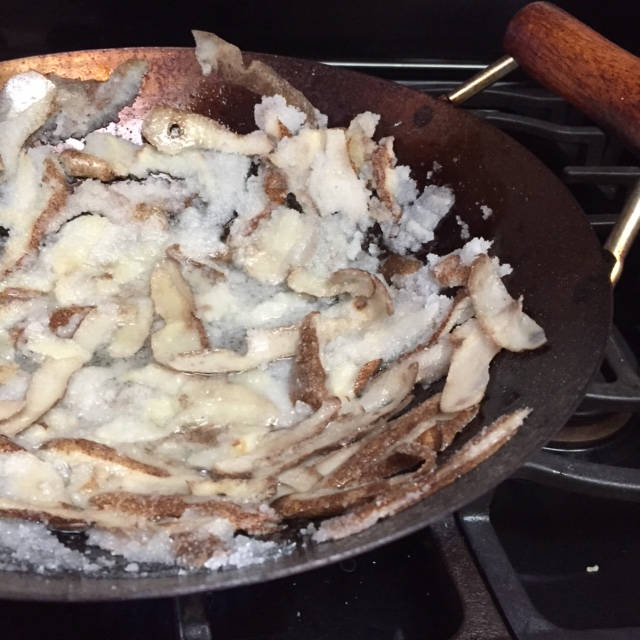
I let the peels and salt gently sizzle all over the wok’s interior. And, this time, I used russets and table salt. No popping and we had mashed potatoes as part of dinner. The interior of the wok was smoothed out and nicely coated by oil. I fried an egg in it. No problem.
However, I mistakenly let the wok sit unattended over high heat and it got way too hot. After it cooled, I noted some uneven lines of gunk. As an experiment, I heated a splash of oil with about 2 to 3 tablespoons of salt in the wok over medium to medium-low heat, then I “scrubbed” it with a paper towel (use fingers or tongs to hold onto the paper towel). The wok got polished and re-seasoned nicely.
The takeaways? The potato peel, salt, and oil method works for seasoning a new carbon-steel pan and likely woks, too. Once you use a carbon-steel pan, wash/rinse it promptly with hot water to remove cooking residue. If stuff get stuck, sticky and mars your finish, try heating oil and salt in the pan to scrub and season the surface. Also, there are many ways to season and re-season a carbon steel pan. Just today, I watched this other video on using flaxseed oil and the oven, which I may try in the future, too.
If you subscribe to Christopher Kimball's new Milk Street magazine, there's a great article on carbon steel pans that explains how they have slightly less carbon than cast iron pans, their ancient, rougher surface relative. The story also suggests a mini seasoning before cooking with carbon steel: Heat the pan over medium, add 1 teaspoon of oil and swirl for 1 to 2 minutes (there may be smoking), then wipe the pan clean with paper towel (use tongs) and you're ready to cook.
Carbon steel pans talk back to you. Each time I use my woks, I learn something new. With the Mauviel, I notice the beautiful colors and patterns change on the metal. To make the pans nonstick requires regular use. They are not like regular nonstick pans coated with Teflon, which can’t be heated up too high. I still use my nonstick pans but I do love the carbon steel ones too. There’s an old-fashioned DIY aspect to building and managing the coating. The effort is worth it because amount of heat, neglect, and abuse that they can take is amazing. The sear is phenomenal to boot!
Gift yourself a carbon-steel wok and/or skillet for the holidays. The high walls of the wok are great for tossing things around. I also adore the wok-hei flavor that food develops and, I love to deep-fry in a wok. Carbon steel skillets are thicker than woks so they hold heat longer and you get knockout searing and sizzling. I'd certainly use a carbon steel skillet in lieu of a wok. Neither costs much so my not have both in your kitchen?
Related post: Nonstick Wok Recommendations













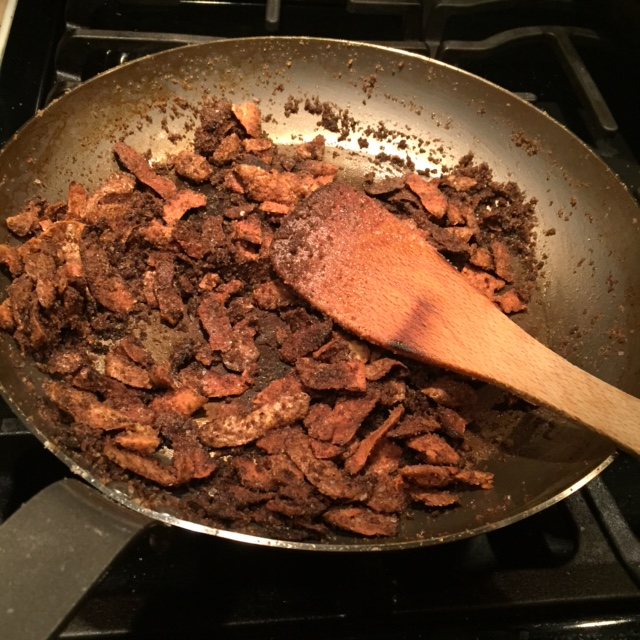
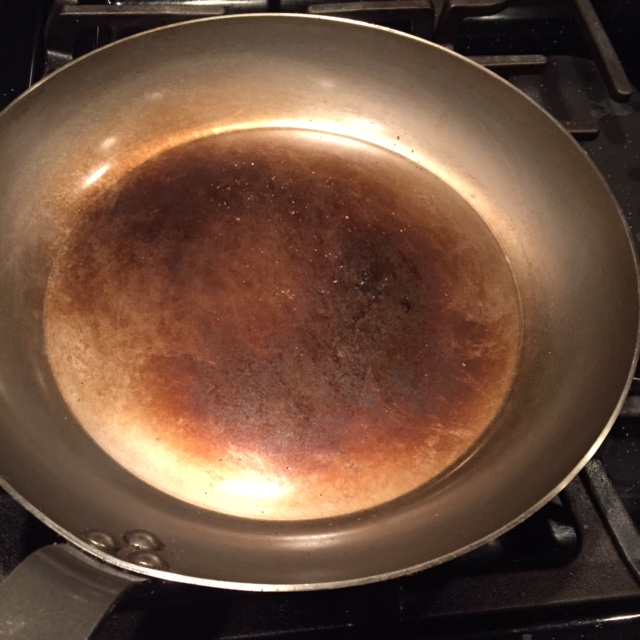
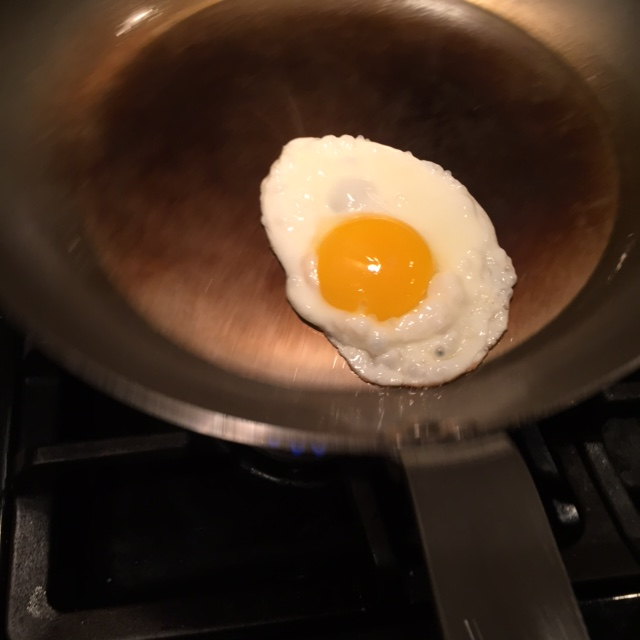
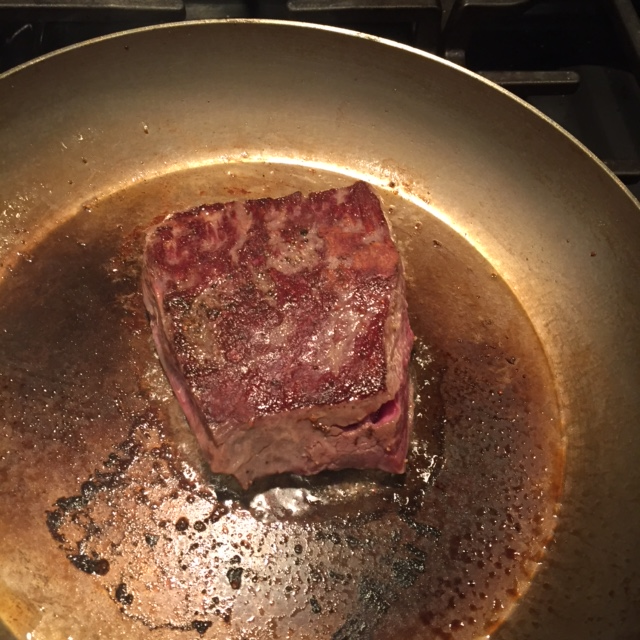
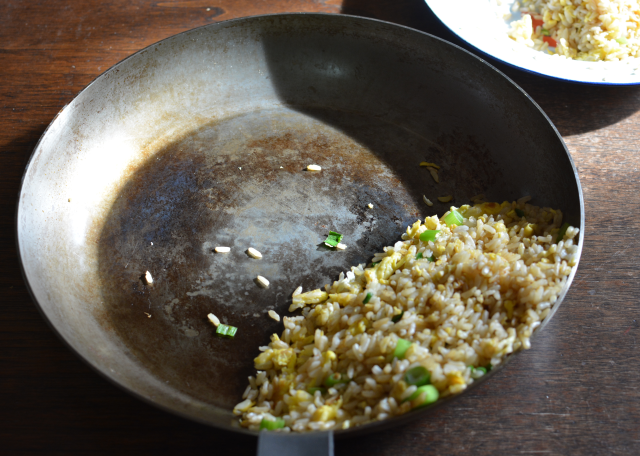




Melanie S says
Thank you for this! I had completed level one of new carbon steel wok seasoning with oil only (after boiling water in it), per manufacturer's instructions and it was a huge, stinky, smoky pain. Then I vaguely remembered reading this post a while back. 🙂 I did the potato-oil-salt method for the second and FINAL round, and my wok looks beautiful. It took me about 20 minutes on my electric, glass top stove; your pictures saved me because I knew what to look for in terms of potato skin and wok coloring. And just like you said, the pan wiped clean with a paper towel and pure magic was left behind. ✨
Andrea Nguyen says
Hooray! I'm soooo thrilled to know that the technique came to your rescue. It's kinda freaky to do but it totally works! Now you can wok with pleasure. Wok on!
Asraf Abid says
This is a nice things to cooking food, Its hardy and long lasting.
Lee says
We just bought two carbon steel pans (8.5" k 10") to use on our new induction stove.
I did the oil (grape seed) heat & cool x10 iterations on the smaller pan. The potato, salt, oil method was done x2 on the larger pan.
The fried egg test was successful on both pans.
I've been doing a few drops of oil and heat before cooking and have had good result.
Great article, thanks for the recommendations and confirming the methods with a very good explanation of the mechanics of the process.
Andrea Nguyen says
Thanks for the feedback, Lee. You're totally set up to cook on hot steel. I love my carbon steel and I hope you get many years of enjoyment from yours.
Amanda Germany says
Hey, Andrea, have you ever tried the ginger/spring onion method for seasoning carbon steel? If so, which method do you prefer?
Andrea Nguyen says
Yes I have, Amanda. Here's you go: https://www.vietworldkitchen.com/blog/2019/11/how-to-season-a-wok.html